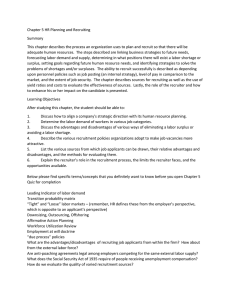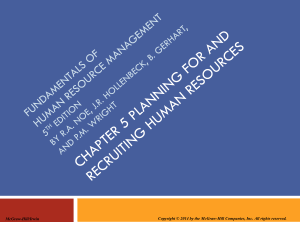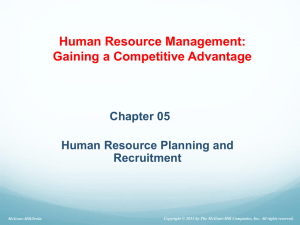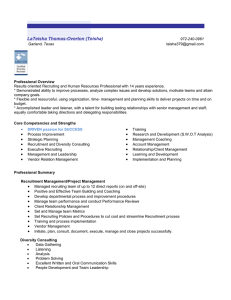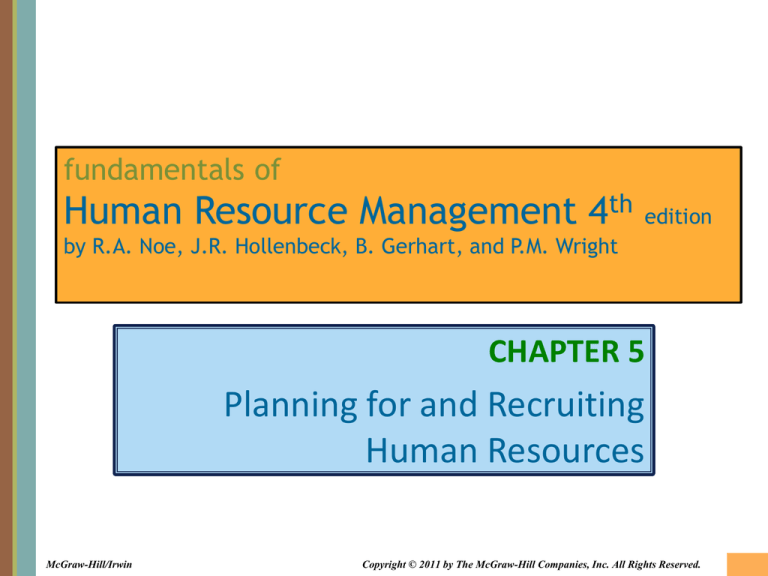
fundamentals of
Human Resource Management 4th
edition
by R.A. Noe, J.R. Hollenbeck, B. Gerhart, and P.M. Wright
CHAPTER 5
Planning for and Recruiting
Human Resources
McGraw-Hill/Irwin
Copyright © 2011 by The McGraw-Hill Companies, Inc. All Rights Reserved.
What Do I Need to Know?
1. Discuss how to plan for human resources
needed to carry out the organization’s
strategy.
2. Determine the labor demand for workers in
various job categories.
3. Summarize the advantages and
disadvantages of ways to eliminate a labor
surplus and avoid a labor shortage.
5-2
What Do I Need to Know? (continued)
4. Describe recruitment policies organizations
use to make job vacancies more attractive.
5. List and compare sources of job applicants.
6. Describe the recruiter’s role in the
recruitment process, including limits and
opportunities.
5-3
The Process of Human Resource Planning
• Organizations should carry out human
resource planning so as to meet business
objectives and gain a competitive advantage
over competitors.
– Human resource planning compares the present
state of the organization with its goals for the
future
– Then identifies what changes it must make in its
human resources to meet those goals
5-4
Figure 5.1: Overview of the Human
Resource Planning Process
5-5
Forecasting
• Forecasting: attempts
to determine the supply
and demand for various
types of human
resources to predict
areas within the
organization where
there will be labor
shortages or surpluses.
There are three major
steps to forecasting:
1. Forecasting the demand
for labor
2. Determining labor
supply
3. Determining labor
surplus or shortage
5-6
Forecasting the Demand for Labor
Trend Analysis
• Constructing and
applying statistical
models that predict
labor demand for the
next year, given
relatively objective
statistics from the
previous year.
Leading Indicators
• Objective measures that
accurately predict
future labor demand.
5-7
Determining Labor Supply
• Transitional matrix: a
chart that lists job
categories held in one
period and shows the
proportion of employees
in each of those job
categories in a future
period.
It answers two questions:
1. “Where did people in
each job category go?”
2. “Where did people now
in each job category
come from?
5-8
Table 5.1: Transitional Matrix – Example
for an Auto Parts Manufacturer
5-9
Determining Labor Surplus or Shortage
• Based on the forecasts for labor demand and
supply, the planner can compare the figures to
determine whether there will be a shortage or
surplus of labor for each job category.
• Determining expected shortages and
surpluses allows the organization to plan how
to address these challenges.
5-10
Goal Setting and Strategic Planning
• The purpose of setting specific numerical goals is to
focus attention on the problem and provide a basis
for measuring the organization’s success in
addressing labor shortages and surpluses.
• The goals should come directly from the analysis of
supply and demand.
• For each goal, the organization must choose one or
more human resource strategies.
• Organizations should retain and attract employees
who provide a core competency (what makes it
better than competitors)
5-11
Options for Reducing a Surplus
Downsizing
Pay
reductions
Demotions
Transfers
Work
sharing
Hiring
freeze
Natural
attrition
Early
retirement
Retraining
5-12
As the average age of many workers in skilled trades grows, the coming
demand for workers in many trades is expected to outstrip supply in the
United States. There is a potential for employers in some areas to
experience a labor shortage because of this.
5-13
Options for Avoiding a Shortage
Overtime
Temporary
employees
Outsourcing
Retrained
transfers
Turnover
reductions
New external
hires
Technological
innovation
5-14
Table 5.2: HR Strategies for Addressing a
Labor Shortage or Surplus
5-15
Test Your Knowledge
• A public accounting firm of 250 employees
realizes they have a surplus of 15 support
personnel (not auditors). What should they
do?
A.
B.
C.
D.
Hire temporary workers
Offer early retirement
Downsize people in those positions
Wait for attrition and implement a hiring freeze
for those positions
5-16
Implementing and Evaluating the HR Plan
• When implementing the HR strategy, the
organization must hold some individual accountable
for achieving the goals.
• That person must also have the authority and
resources needed to accomplish those goals.
• Regular progress reports should be issued.
• The evaluation of results should not only look at the
actual numbers, but should also identify which parts
of the planning process contributed to success or
failure.
5-17
Applying HR Planning to Affirmative Action
• Workforce Utilization
Review: a comparison of
employees in protected
groups with the
proportion that each
group represents in the
relevant labor market.
• The steps in a workforce
utilization review are
identical to the steps in
the HR planning process.
• The organization must
assess current utilization
patterns, then forecast
how they are likely to
change in the near future.
• If the analyses forecast
underutilization of certain
groups, then goals and a
plan will be established.
5-18
Recruiting Human Resources
• The role of human resource recruitment is to
build a supply of potential new hires that the
organization can draw on if the need arises.
• Recruiting: any activity carried on by the
organization with the primary purpose of
identifying and attracting potential
employees.
5-19
Figure 5.2: Three Aspects of Recruiting
5-20
Personnel
Policies
Internal versus
external recruiting
Several personnel
policies are
especially relevant
to recruitment:
Lead-the-market pay
strategies
Employment-at-will
policies
Image advertising
5-21
• Image advertising, such
as in this campaign to
recruit nurses, promotes
a whole profession or
organization as opposed
to a specific job opening.
• This ad is designed to
create a positive
impression of the
profession, which is now
facing a shortage of
workers.
5-22
Recruitment Sources: Internal Sources
• Job Posting: the process of communicating
information about a job vacancy:
– On company bulletin boards
– In employee publications
– On corporate intranets
– Anywhere else the organization communicates
with employees
5-23
Advantages of Internal Sources
1. It generates applicants who are well known to
the organization.
2. These applicants are relatively knowledgeable
about the organization’s vacancies, which
minimizes the possibility of unrealistic job
expectations.
3. Filling vacancies through internal recruiting is
generally cheaper and faster than looking
outside the organization.
5-24
One in Three Positions Are
Filled with Insiders
5-25
Recruitment Sources: External Sources
Direct applicants
Public employment
agencies
Referrals
Advertisements in
newspapers and
magazines
Private employment
agencies
Colleges and
universities
Electronic recruiting
5-26
Figure 5.3: External Recruiting Sources –
Percentage of Employees Hired
5-27
Evaluating the Quality of a Source
Yield Ratios
Cost Per Hire
• A ratio that expresses the
percentage of applicants who
successfully move from one
stage of the recruitment and
selection process to the next.
• By comparing the yield ratios of
different recruitment sources,
we can determine which source
is the best or most efficient for
the type of vacancy.
• Find the cost of using a
particular recruitment source
for a particular type of vacancy.
• Divide that cost by the number
of people hired to fill that type
of vacancy.
• A low cost per hire means that
the recruitment source is
efficient.
5-28
Table 5.3:
Results of a Hypothetical Recruiting Effort
5-29
Your Experience
• In your last job search, what was your
experience with a recruiter or other point of
contact before you were offered the job?
A.
B.
C.
D.
E.
Lousy, I didn’t take the job
Lousy, but I took the job anyway
Great, but I didn’t take the job
Great, I took the job
The experience wasn’t memorable.
5-30
Recruiter Traits and Behaviors
Characteristics of the Recruiter
Behavior of the Recruiter
Enhancing the Recruiter’s Impact
5-31
Recruiter Characteristics and Behavior
True = A False = B
• Applicants respond more positively when the recruiter
is an HR specialist than line managers or incumbents.
• Applicants respond positively to recruiters whom are
warm and informative
• Personnel policies are more important than the
recruiter when deciding whether or not to take a job.
• Realistic job previews should highlight the positive
characteristics of the job rather than the negative.
5-32
Figure 5.4:
Recruits Who Were Offended by Recruiters
5-33
Enhancing the Recruiter’s Impact
• Recruiters should provide timely feedback.
• Recruiters should avoid offensive behavior.
• They should avoid behaving in ways that might
convey the wrong impression about the
organization.
• The organization can recruit with teams rather
than individual recruiters.
5-34
Recruiting Exercise (1 of 2)
• You are the regional HR director of the
restaurant chain (e.g., Ruby Tuesday’s or TGI
Fridays) and responsible for recruiting all staff
for the restaurants in your region.
• One of the stores in your region needs to hire
servers.
5-35
Recruiting Exercise (2 of 2)
1. What knowledge, skills, and abilities are
required for the positions you are recruiting?
2. Will your sources of applicants be internal,
external, or both? Explain.
3. What recruiting strategies will you use?
4. What metrics will you use to measure your
success?
5-36
Summary
• The first step in human resource planning is
personnel forecasting. Through trend analysis and
good judgment, the planner tries to determine the
supply and demand for various human resources.
• The next step is to determine the labor demand for
workers in various job categories. Analysis of a
transitional matrix can help the planner identify
which job categories can be filled internally and
where high turnover is likely.
5-37
Summary (continued)
• To reduce a surplus, downsizing, pay reductions, and
demotions deliver fast results but at a high cost in
human suffering that may hurt surviving employees’
motivation and future recruiting.
• To avoid a labor shortage, requiring overtime is the
easiest and fastest strategy.
• Internal recruiting generally makes job vacancies
more attractive because candidates see
opportunities for growth and advancement.
5-38
Summary (continued)
• Lead-the-market pay strategies make jobs
economically desirable.
• Internal sources are usually not sufficient for all of an
organization’s labor needs.
• Through their behavior and other characteristics,
recruiters influence the nature of the job vacancy
and the kinds of applicants generated.
5-39

